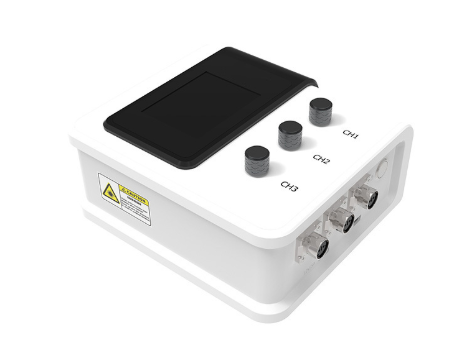High-power Three-channel LED Light Source
ORI-KJ-09-HT02 is a high-power three-channel LED for applications such as microscope illumination, multi-color fluorophore excitation. The device consists of three high-power LED light sources, collimating elements, dichroic frames, radiators and other mechanical parts. The design can realize 10° divergence Angle, stable output power, and and minimal overheating damage. The three-channel LED can realize the flexible wavelength combination, easy assembly and disassembly, continuous or millisecond pulse output through the controller, light intensity continuously adjustable.
Product Classification:
LED fluorescence light source
key word:
Fluorescent Imaging
High-power
Three-channel
LED Light Source
fluorescence microscopy
Product Details
ORI-KJ-09-HT02 is a high-power three-channel LED for applications such as microscope illumination, multi-color fluorophore excitation. The device consists of three high-power LED light sources, collimating elements, dichroic frames, radiators and other mechanical parts. The design can realize 10° divergence Angle, stable output power, and and minimal overheating damage. The three-channel LED can realize the flexible wavelength combination, easy assembly and disassembly, continuous or millisecond pulse output through the controller, light intensity continuously adjustable.
Table1. Parameters Table
|
Category |
High-power Three-channel LED Light Source |
|
Wavelength |
365-1500nm optional,for details of NIR (980-1450nm) and UVA-UVC (254-365nm), please consult separately |
|
Optical Power |
Details as bellowed table 2 |
|
Optical Spot Size (at exit) |
D=25mm |
|
Angle of Divergence |
<10° |
|
Lifetime |
>10000h |
|
Operating Temperature |
0~40℃ |
|
Storage Temperature |
-40~70℃ |
|
Dimension |
244.5×218×60mm |
|
Weight |
2800g |
Operating Environment
The LED will gradually heat up when using, which will lead to the attenuation of optical power and even shorten the life of the LED. We have excellent heat dissipation structure design, which can prolong the lifetime of LED light source and reduce power loss. Please work in a ventilated environment to avoid overheating, to avoid the decrease of optical power and shorten the lifetime of LED.
Table 2. LED Typical Optical Characteristics
Recommendation: Select the wavelength through three ranges, 365-505nm, 510-600nm, 600-750nm, and other combinations are separately consulted.
|
Peak wavelength(nm) |
Range(nm) |
Radiated Optical Power(mW) |
Spectral FWHM(nm) |
|
365 |
365-370 |
900-1100 |
9 |
|
380 |
380-390 |
1100-1300 |
12 |
|
400 |
400-405 |
800-1000 |
17 |
|
410 |
410-420 |
700-800 |
16 |
|
420 |
420-430 |
700-800 |
17 |
|
430 |
430-440 |
600-800 |
19 |
|
455 |
455-460 |
600-800 |
20 |
|
470 |
470-480 |
800-1000 |
20 |
|
480 |
480-485 |
400-600 |
23 |
|
520 |
520-525 |
240-300 |
30 |
|
535 |
535-545 |
160-240 |
30 |
|
550 |
540-560 |
120-160 |
40 |
|
560 |
550-570 |
120-160 |
40 |
|
590 |
580-600 |
120-160 |
25 |
|
625 |
615-635 |
600-700 |
15 |
|
660 |
655-665 |
400-600 |
20 |
|
730 |
720-740 |
400-500 |
22 |
1.The wavelength error is ±5.0nm, and the radiated optical power error is ±5%. The above parameters are for reference only, and the actual factory test data shall prevail.
2. All Specifications subject to change.
Power Supply
We provide the corresponding light source driver, as shown in the figure below. If you are equipped with a constant current drive power supply, please contact us for the pin diagram and strictly follow it when connecting. At the same time, please ensure that the operating current does not exceed the maximum allowable value, provide sufficient forward voltage, and connect the pins correctly.

 Maintenance & Service
Maintenance & Service
To avoid damage, do not expose them to sprays, liquids or solvents, and do not open the outer covering. In case of failure, please contact service@oricszlab.com, we will provide you with after-sales service and technical support as soon as possible.
 Warning and safety
Warning and safety
This LED is not suitable for home interior lighting, must not be operated in explosive atmospheres, and can only be used with shielded connecting cables.
UV Warning
The LED emits strong light when working. Part of the LED emission spectrum contains UV components. Do not look directly at the LED light during operation, even a short exposure time may be harmful to the eyes. If direct viewing of the beam is required, protective goggles must be worn to avoid eye injury.
GET IN TOUCH





